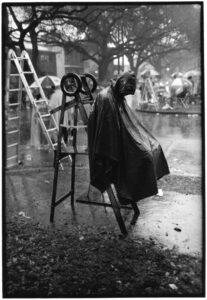Matthew Anderson IV
For three decades, photographer Matt Anderson has focused his camera on New Orleans's musicians, cultural events, and the performing arts.

Courtesy of Matt Anderson
Balzac Holds His Spot. Anderson, Matt (photographer)
A the age of eighteen, when Matthew Anderson IV came to New Orleans as a Tulane University undergraduate, he had already been taking pictures for eight years. A native of Miami, Florida, born to Matthew Anderson III and Julia Siry, Anderson found a home in New Orleans and has photographed the city extensively in his decades-long residency, while also using it as a base of operations to photograph elsewhere. He cites numerous influences from many fields on his work as a photographer: photographers Henri Cartier-Bresson, Ralston Crawford, Robert Frank, and Walker Evans; editors John Loengard, Edward Steichen, and Roy E. Stryker; painters John Singer Sargent, James McNeil Whistler, and Newell Convers Wyeth; poets Emily Dickinson, Robert Frost, Donald Hall, and Philip Levine; writers John Berger, John Collier, Gordon Parks, and Eudora Welty; and filmmakers Robert Flaherty and Ingmar Bergman.
Over the course of nearly three decades (1975–2002), extended travel to Guatemala, the United Kingdom and Ireland, continental Europe, and the former Soviet Union have permitted Anderson an especially rich mix of photographic opportunities. Though his freelance practice began in college and included a wide variety of subjects, his most concentrated work is in the photographs he made in New Orleans of musicians, cultural events, and the performing arts—from jazz funerals to high society gatherings, and from ballet to symphonic music. Anderson’s archive was mostly destroyed by Hurricane Katrina in 2005 or dispersed in the confusion that followed.
While enrolled at Tulane in the 1960s, Anderson gained photographic experience that served to guide his future direction as a photojournalist. He worked for the university’s newspaper, The Hullaballoo, and though principally an editor, learned darkroom techniques there. Anderson’s tenure as the paper’s editor and editor for the school’s yearbook The Jambalaya coincided with that of New Orleans documentary photographer Michael P. Smith, who was enrolled at Tulane. Anderson would later photograph the school’s football games with Smith from 1973 to 1974 and share a darkroom with him from 1973 to 1975.
While a student in 1970, Anderson began photographing the productions of the Tulane Summer Lyric Theatre, something he continued following his studies until 1978. This marked the beginning of his photographing performing arts events. During the 1980s, he documented productions of the Delta Festival Ballet and Ballet Hysell companies of New Orleans, and for the then-active New Orleans Symphony, whose Parisian tour Anderson photographed in 1982. These years also included occasional assignments for the Houston Ballet, and for the publications Ballet News, Dance Magazine, and Soviet Ballet.
As an assignment photojournalist, Anderson’s work on a variety of subjects saw publication in many newspapers and magazines, and for many different purposes. From 1979 (when he photographed the Jackson, Mississippi, Ballet) until 2004 (when he photographed the New Orleans Mardi Gras Indians on Bayou St. John on St. Joseph’s Day), Anderson regularly supplied the New York Times with photographs from Louisiana and a six-state surrounding region. Among his work for that newspaper were portraits of writers Robert Olen Butler and Richard Ford, Louisiana governor Edwin W. Edwards, and Arkansas architect E. Fay Jones. Over the years of his association with the Times, Anderson had more than100 published photographs. Between 1980 and 1982, he covered social events for the Times-Picayune of New Orleans. From 1997 to 1998, Anderson lived in Vermont and his photographs appeared in the Rutland Herald, the Burlington Free Press, and the Brattleboro Reformer, sometimes accompanying stories written by Lillian Legardeur, to whom he was married at the time. Features of his work saw publication in the Connacht Tribune of Galway, Ireland (1999) and Rocky Mountain News (2000). Though Anderson primarily photographed in black and white, during this period the Christian Science Monitor published some of his work in color.
Exhibitions are not often an opportunity for those who work primarily in photojournalism, but Anderson’s work has been exhibited since 1973 (when it was included in a group show at New Orleans’ Gallier Hall). He had his first solo exhibition in 1975, when the main branch of the New Orleans Public Library exhibited his photographs of dance. At that time Anderson was involved in the activities of the New Orleans Photo Exchange, a gallery, darkroom, and programming space for photography in downtown New Orleans. In 1985, Images Gallery in New Orleans mounted a solo exhibition of his photographs. In 2005, the Bruno Gallery in New Orleans presented what to date is his last solo exhibition.
Anderson’s work was exhibited in a juried group exhibition at the Southeastern Center for Contemporary Art in Winston-Salem, North Carolina (1981). He was half of a two-person show at the Academy Gallery in New Orleans in 1987. In 2010, his work was included in an exhibition, Residents and Visitors: 20th Century Louisiana Photographs, at the New Orleans Museum of Art. Anderson’s photographs are in the holdings of the William Ransom Hogan Jazz Archive of Tulane University, The Historic New Orleans Collection, and the Allen Memorial Art Museum at Oberlin College.
